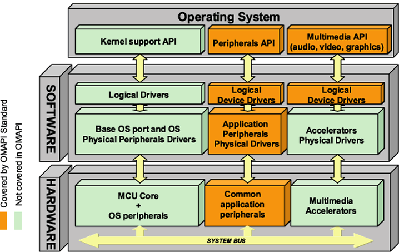OMAPI processor standard gains support
Feb 3, 2003 — by LinuxDevices Staff — from the LinuxDevices Archive — 1 viewsTexas Instruments (TI) and STMicroelectronics (ST) today simultaneously announced new application processors based on the TI/ST “OMAPI” standard. The new chips target 2.5G and 3G mobile phones, PDAs, and other portable/multimedia products including automotive applications and support operation under embedded Linux (as well as several other embedded OSes).
In December, 2002 TI and ST launched an initiative to jointly define and promote an open standard for wireless application processor interfaces. Called “OMAPI,” which stands for “Open Mobile Application Processor Interface,” the effort aims to define a set of software interfaces to the operating system, plus a set of hardware interfaces defining common application peripherals.
OMAPI, as its name implies, is derived from TI's OMAP application processor family.

OMAPI system architecture
In January, 2003, Nokia endorsed OMAP, saying, “Nokia acknowledges that the OMAPI standard initiative . . . is a significant and positive step in building open mobile application processor interfaces, as well as boosting growth in the mobile industry. Harmonization in the application processor interfaces is becoming increasingly important as multimedia enabled mobile terminals and new applications are making their way to the mass market . . . We are looking forward to seeing a strong success of the OMAPI initiative . . .”
For further info on the TI/ST OMAPI initiative is available here.
ST's new OMAPI family
ST today unveiled first details of its new family of multimedia application processor chips based on OMAPI. The new “Nomadik” chips are based on a dual-core design consisting of a 350-500MHz ARM926 core along with what ST calls programmable “smart accelerators,” which independently handle key video and audio coding functions, including pre/post-processing. Encoding standards such as MP3, MPEG2-Layer II, MPEG2/4-AAC, Dolby Digital, H.263, and H26L (H.264) are supported on the “smart accelerators,” and embedded Linux is supported for operation of the ARM926 core processor (as well as several other embedded OSes).
Details on ST's new OMAPI-compliant Nomadik processors are available here.
TI's new OMAP processors
TI today announced five new members of its OMAP processors processor family. The new processors are said to be software-compatible with the previous OMAP processors. Three of the devices (OMAP1610, OMAP1611, OMAP1612) can be coupled with chipsets for cellular standards, and the other two (OMAP730, OMAP732) combine a TI GSM/GPRS modem baseband subsystem with a dedicated application processor within a single chip.
TI also says its new OMAP processors are the first processors to feature comprehensive built-in wireless security hardware, capable of providing strong protection and fast security services for protecting the ownership rights of creative content or software, guarding confidential information, and securing sensitive information transmission.
Like ST, TI supports operation of the RISC applications processor within its dual-core OMAP processors under embedded Linux (as well as several other embedded OSes).
Further information on TI's new OMAP processors are available here.
This article was originally published on LinuxDevices.com and has been donated to the open source community by QuinStreet Inc. Please visit LinuxToday.com for up-to-date news and articles about Linux and open source.